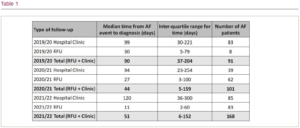Introduction: With the rapid implementation of remote follow-up (RFU) during the COVID-19 period, the cardiac devices population under Royal Papworth Hospital has benefitted from this technology, with a great increase in patients followed up remotely, from 19.7% at pre-pandemic level, to 56.7% in the first year of the pandemic and 61% in the year after the pandemic, and currently accounts for 75% of patients under remote monitoring. RFU allows quicker detection and treatment of arrhythmias, as well as device issues. This project aimed to identify the benefits of RFU in detecting and treating patients with new onset of AF.
Methods: A sample of 360 AF letters completed was retrospectively collected for the year before (April 2019 to March 2020) and after (April 2020 – March 2021 and April 2021 – March 2022) the COVID-19 pandemic, when changes to the management of cardiac devices occurred in our service, favouring RFU. AF letters are sent to patients and General Practitioners (GPs), when an AF episode has been detected for >6 minutes as per current guidelines and patients are identified as not anticoagulated.
Results: Time to diagnosis was significantly shorter for patients who had RFU automatic downloads than for those on routine, manual download clinics (p<0.01 for the 2020/21 and 2021/22 year groups using the Mann–Whitney U test). In the data from the 2021/22 group, which had the largest number of patients, the median time to diagnosis in the auto group was just 5 days (IQR 1–22 days), whilst it was 50 days (IQR 14–118 days) for patients using routine manual downloads of symptoms.
Conclusions: The overall reduction in number of days from the first actionable event to diagnosis appeared to be due to the fact that a higher number of patients were under RFU. In the latest period analysed, there was a small increase in time from event to diagnosis and this can be explained as the greatest increase in RFU proportion of devices enrolled during this period being pacemakers, many of which still require manual transmissions. Traditionally, a higher number of complex devices such as tachy and cardiac resynchronisation therapy devices were enrolled in RFU pre-pandemic, and these provide automatic transmissions allowing quicker diagnosis of episodes. Despite the fact that alerts for atrial arrhythmia can be triggered differently across all manufacturers and device type, as well as different RFU transmission mechanisms including automatic transmissions and manual transmissions, RFU overall appears to play a significant role in detecting these and allowing early diagnosis. Early diagnosis of AF is essential to reduce the risk of stroke.








